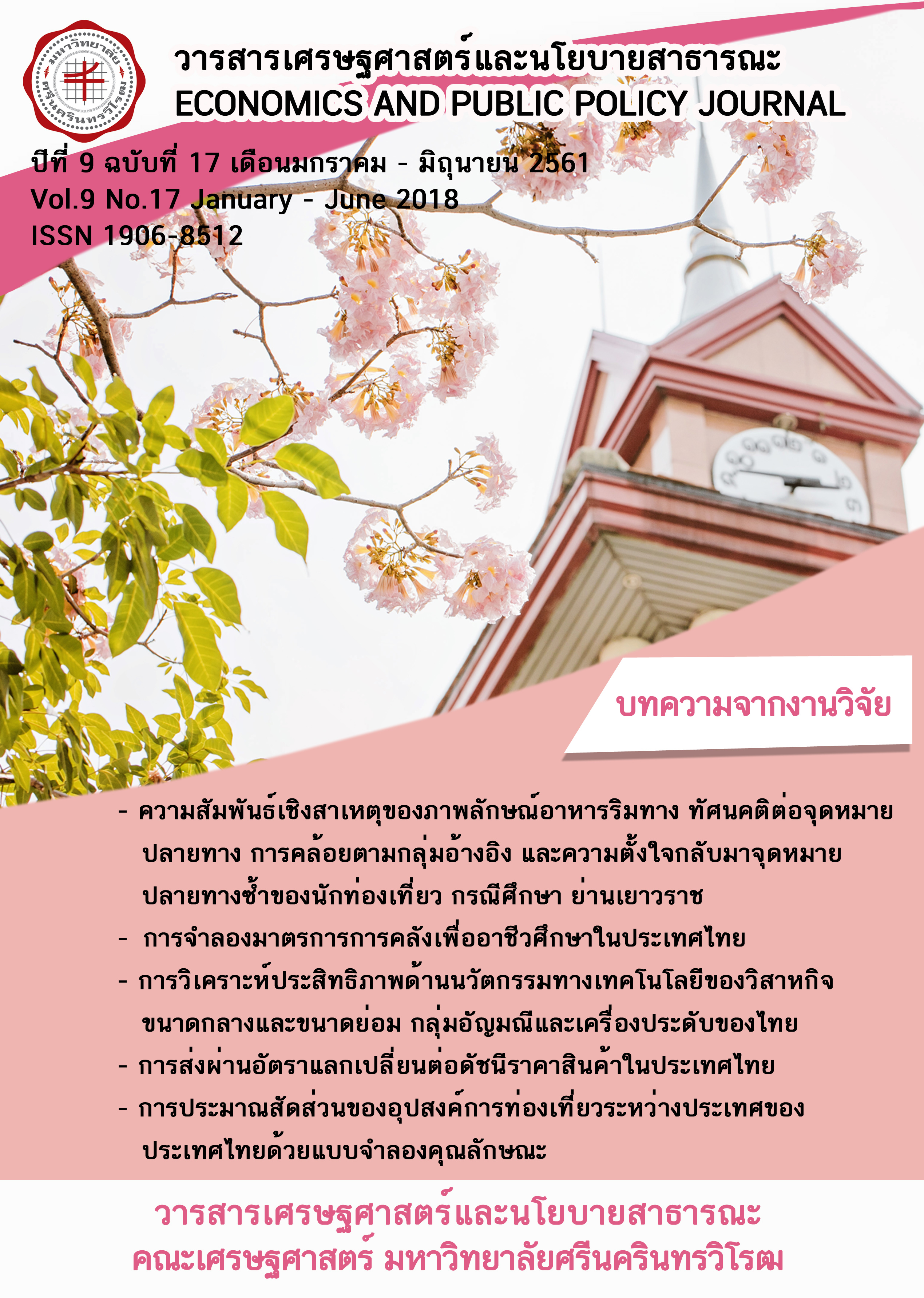การส่งผ่านอัตราแลกเปลี่ยนต่อดัชนีราคาสินค้าในประเทศไทย
Main Article Content
บทคัดย่อ
Understanding the exchange rate pass-through is an important implication for all central banks in open economies such as Thailand as it helps policy makers forecast inflation and decide how much to tighten monetary policy regarding to an inflation increasing. This paper investigates the degree of exchange rate pass-through in Thailand, using the new framework called the nonlinear autoregressive distributed lags (NARDL) introduced by Shin et al. (2013). The advantage of this model is to simultaneously accommodate asymmetry in both the long-run and short-run pass-through. The results reveal the zero pass-through to the Consumer Price Index (CPI) and Producer Price Index (PPI) in the long-run, implying that Thai Baht depreciation (or appreciation) does not affect any domestic prices in Thailand in the long-run. However, the partial pass-through to CPI and PPI exists in the short-run. Also, the results strongly confirm the asymmetric pass-through in the short-run which an appreciation of Thai Baht is passed-through more strongly than a depreciation of Thai Baht.
Article Details
สงวนลิขสิทธิ์ © 2553 คณะเศรษฐศาสตร์ มหาวิทยาลัยศรีนครินทรวิโรฒ
คณะเศรษฐศาสตร์ มหาวิทยาลัยศรีนครินทรวิโรฒ จัดพิมพ์วารสารเศรษฐศาสตร์และนโยบายสาธารณะ เพื่อเผยแพร่บทความวิชาการทางเศรษฐศาสตร์ นโยบายสารธารณะ และสาขาอื่นๆที่เกี่ยวข้อง ทัศนะและข้อคิดเห็นใดๆ ที่ปรากฏในวารสารเป็นความคิดเห็นส่วนตัวของผู้เขียน โดยบทความที่ได้รับการตอบรับจะถือเป็นลิขสิทธิ์ของคณะเศรษฐศาสตร์ มหาวิทยาลัยศรีนครินทรวิโรฒ
บรรณาธิการ อาจารย์ ดร.พลพัธน์ โคตรจรัส
เอกสารอ้างอิง
Bussiere, M. (2007). Exchange rate pass-through to trade prices: The role of non-linearities and asymmetries. European Central Bank Working Paper 822.
Campa, J., & Goldberg, L. (2005). Exchange Rate Pass-Through into Import Prices. The Review of Economics and Statistics, 87, 679-690.
Choudhri, E.U., & Hakura, D.S. (2006). Exchange rate pass-through to domestic prices: Does the inflationary environment matter? Journal of International Money and Finance, 25, 614-639.
Coulibaly, D., & Kempf, H. (2010). Does inflation targeting decrease exchange rate pass- through in emerging countries? Centre d’Economie de la Sorbonne Working Papers 49.
Delatte, A-L., & Lopez-Villavcencio, A. (2012). Asymmetric exchange rate pass-through: evidence from major countries. Journal of Macroeconomics, 34, 833-844.
Edwards, S. (2006). The relationship between exchange rates and inflation targeting revisited. National Bureau of Economic Research Working Paper 12163.
Eichengreen, B. (2002). Can emerging markets float? Should the inflation target? Banco Central Do Brasil Working Paper Series 36.
El bejaoui, H.J. (2013). Asymmetric effects of exchange rate variations: An empirical analysis for four advanced countries. International Economics, 135-136, 29-46.
Flamini, A. (2007). Inflation targeting and exchange rate pass-through. Journal of International Money and Finance, 26(7), 1113-1150.
Ihrig, J., Marazzi, M., & Rothenberg, A. (2006). Exchange rate pass-through in the G7 countries. Board of Governors of the Federal Reserve System, International Finance Discussion Paper 851.
Krugman, P. (1987). Pricing to Market When the Exchange Rate Changes, in Arndt, S. and Richardson, J., Real-Financial Linkages Among Open Economies, Cambridge, MA, MIT Press.
Mishkin, F.S. (2008). Exchange rate pass-through and monetary policy. National Bureau of Economic Research Working Paper 13889.
Nogueira Junior, R.P. (2006). Inflation targeting, exchange rate pass-through and fear of floating. Department of Economics Discussion Paper 06(05), University of Kent.
Nogueira Junior, R.P. (2007). Inflation targeting and exchange rate pass-through. Economia Aplicada, 11(2), 189-208.
Pavasuthipaisit, R. (2010). Should inflation-targeting central banks respond to exchange rate movements? Journal of International Money and Finance,29, 460-485.
Pollard, P.S., & Coughlin, C.C. (2004). Size matters: Asymmetric exchange rate pass-through at the industry level. Federal Reserve Bank of St.Louis Working Paper 2003-29C.
Prasertnukul, W., Kim, D., & Kakinaka, M. (2010). Exchange rates, price levels, and inflation targeting: evidence from Asian countries. Japan and the World Economy, 22, 173-182.
Reyes, J. (2007). Exchange rate passthrough effects and inflation targeting in emerging economies: What is the relationship? Review of International Economics, 15(3), 538-559.
Schmidt-Hebbel, K., Werner, A., Hausmann, R., & Chang, R. (2002). Inflation targeting in Brazil, Chile, and Mexico: Performance, Credibility, and the exchange rate [with comments]. Economia, 2(2), 31-89.
Sekine, T. (2006). Time-varying exchange rate pass-through: experiences of some industrial countries. Bank for International Settlements Working Paper Series 202.
Shin, Y., Yu, B., & Greenwood-Nimmo, M. (2013). Modelling asymmetric cointegration and dynamic multipliers in an ARDL framework. SSRN Working Paper 1807745.
Taguchi, H., & Sohn, W-K. (2010). Inflation targeting and pass-through rate in East Asian Economies. Policy Research Institute Discussion Paper Series No.10A-08.
Webber, A.G. (2000). Newton’s gravity law and import prices in the Asia Pacific. Japan and the World Economy, 12, 71-87.


